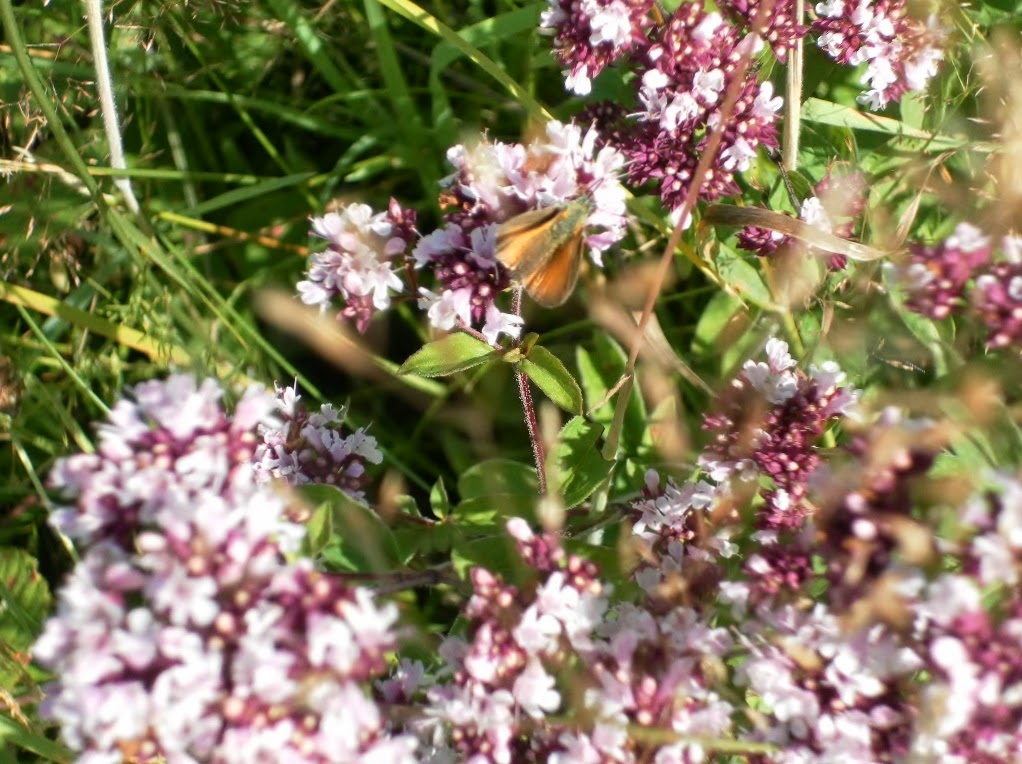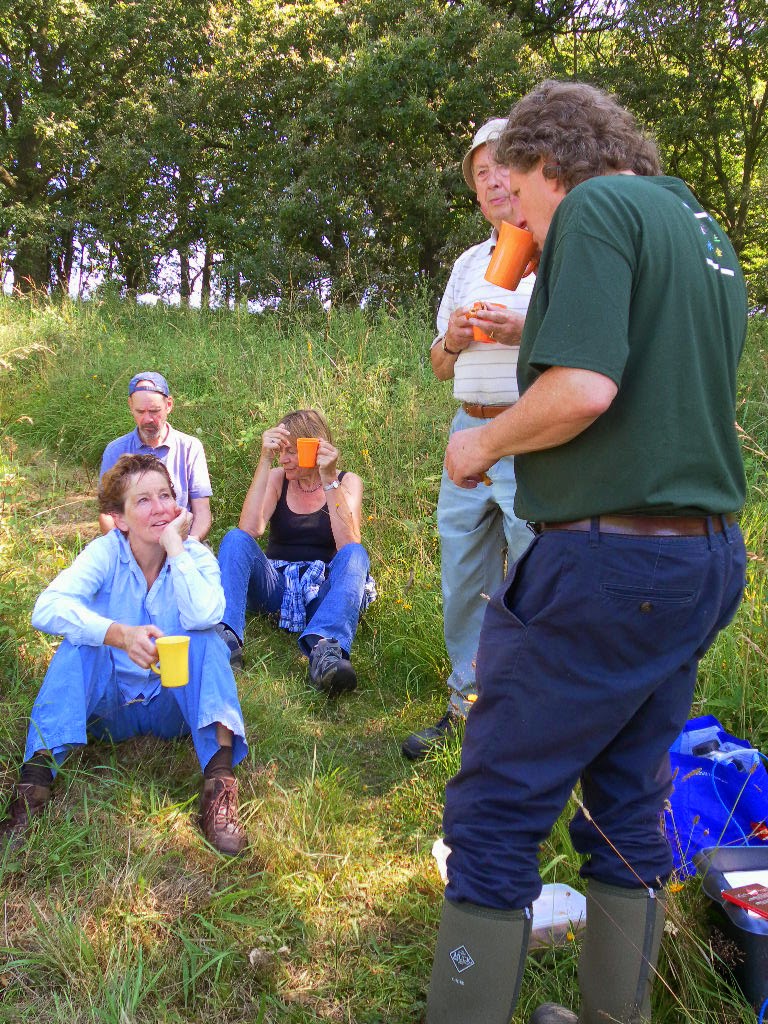… ’cause he’s
so hard to see,” sang the Beatles.
Wallingford
Green Gym came together this morning
to clear what are meant to be Permissive Pathways (as opposed to Public Rights of Way). When paths become that overgrown, people
visiting the site can’t see that there are meant to be routes through, and
neither can the sheep. That means that
the livestock limit themselves to grazing ever smaller areas of pasture, which
is not good.
So a loppers
and shears task:
Note the
neat more-than-fashion accessory:
As for long sleeves,
this was not because it was not a warm day.
It was in fact very hot, especially within the parabola formed by the
terrain. Long sleeves are good defence
against insect and plant life, most of which seemed intent on biting, stinging,
or clawing one to death if it could.
The first
question was not, as one might expect, “Where is the line of the path?” It was, looking down into the valley below, “Are
those cattle around a water trough?”
(What look like little brown dots on the valley floor, right-hand side
of the photograph, just above the line of scrub on the near-valley hillside:)
Answers
(variously):
“No, it’s an electricity pylon”“Should’ve gone to Specsavers!”
It was a day
for having sharp eyes. Here, for
example, is the larva of a cinnabar moth (Tyria jacobaeae)
feeding on What Cinnabar-moth-larvae Like Best: ragwort. The toxins (which somehow don’t seem to
affect them) are what gives them their Tigger-like appearance, and presumably
stop them from being eaten in turn:
For all the
clouds of butterflies already on the wing in the chalk-grassland meadow
alongside, it was hard to pick out individuals.
We had heard from another visitor to the site that the Silver-Spotted
Skipper had been spotted unusually early on Bald Hill. This, however, is not a Silver-Spotted
Skipper – more like an ordinary Small Skipper:
This one, I
think, is just a Meadow Brown, perched on what another Green-Gymmer identified
as a scabious (? Field Scabious: Knautia
arvensis):
The prettiest
butterflies were the hardest to photograph. The ghostly
one which I guessed to be a Marble White barely stopped still for a second:
 |
| Front profile |
 |
| Profile from above |
The
electric-blue one (Adonis Blue or just a Common Blue?) would not stop for a photo-call at
all. So you’ll just have to take my word
for its dazzling colour.
Green-Gymmers
could also be hard to spot at a distance.
For there were two path-lines to be cleared, which for the first fifty
metres ran in parallel. This was the
view from the one work-area to the other:
To take
their tool order (“More shears, please!”) meant walking round, and discovering
that they too had plenty of brambles to deal with:
There the
most pressing question seemed to be, “What are brambles for?” Which drew these
responses on the spot:
“They’re for keeping out humans!”“They’re great for undoing your shoe-laces ...”“… Or tripping you up.”“They’re where the blackberry bit in your blackberry-and-apple pie comes from.”
Other uses
for brambles (not an exhaustive list):
- They provide food (pollen and nectar) for useful insects like bees, and pretty insects such as butterflies
- They provide food (fruit) for birds and small mammals – and the larder keeps overwinter (at least for animal consumption: human beings leave the fruit once it has been touched by frost)
- Indirectly they provide food for spiders, because they are good places to spin webs to ambush visiting insects
- The arching vegetation provides shelter from the elements for birds and small mammals
- The thorns provide birds and small mammals with protection from predators
- The barbs can also be exploited by humans to create natural stock-fencing or a fortified perimeter for a village/homestead
- The long stems, when they have been softened by winter frosts, can be used for twine or rope – this was common practice in East Anglia until relatively recent times. Hence the nursery rhyme, which now reads nonsensically, “Here we go going gathering nuts in May.” Corrected to “Here we go gathering knots in May”, it makes sense if you know that ‘knots’ was dialect for ‘lengths of rope’.
- In spring, while the thorns are still soft, fresh leaf shoots can be eaten: peeled and added to salads; or steamed/boiled as an alternative to spring greens; or added to soup along with young nettle leaves
- The leaves when young can be made into a medicinal infusion against sores/inflammation in the mouth
- Later in the year, the mature leaves make a tasty brew, which is just nice to drink
- The root can be made into a herbal remedy for stomach upsets
- The fruit can be used for a purple/deep-blue dye
Tea-break
was held in a shady spot cooled by the breeze:
Note the T-shirt
on the right (home-designed by one of our members: thamestaichi@gmail.com). The front features the stylised Uffington
White Horse. Also available in tasteful
orange:
The
principal question posed in the second half of the morning was: “What’s the
difference between a cyclone and a hurricane – or a typhoon?” (Prompted by one member’s recent experience
of the aftermath of a cyclone, where there would have been plenty for a
Green-Gym team to do by way of clearing.)
A little research tells me that, as we suspected, it all depends on
where it’s happening. The same
meteorological phenomenon is called:
- a hurricane if it’s in the Atlantic or NE Pacific (morphs into a ‘tornado’ when it comes ashore)
- a cyclone if it’s in the South Pacific or Indian Ocean
- a typhoon if it’s in the NW Pacific
After the morning
session, there was more ‘work’ for Green Gym, but only in the form of lunch and
the AGM 2014 at a nearby hostelry. For
which we were joined by Angel (correctly identified by most of our party as a
macaw, not a cockatoo):
The angle of the photograph is a tad deceptive. She is in fact more interested in preening herself than in discovering whether parrots like lime-and-soda.











Nice photos. Good task. Good blog!
ReplyDelete